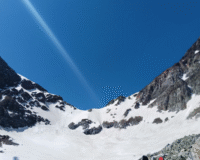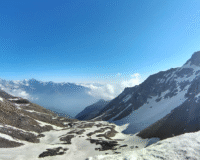My Journey Through the Himalayas: An Unforgettable Experience on the Buran Ghati Trek
There are some treks that leave a print on your soul, that redefine how you perceive mountains, silence, and even yourself. The Buran Ghati Trek did that for me. Situated in the unexplored terrain of Himachal Pradesh, the high-altitude trek did everything I had wished it to—thrills, beauty, isolation, and a sense of oneness with nature that I never knew I was deprived of.
The Decision to Trek Buran Ghati
It began with a desire to do something uncooked—something more than the normal touristy routes. A friend had done the Buran Ghati Trek a year earlier and would not stop raving about the ice wall rappel down, the green meadows, and the serene Himalayan villages. I was hooked. With some reading and general fitness preparation, I enrolled in the trek set for early June—just when the trail starts opening up after the winter snow.
First Impressions: Arriving at Janglik Village
We started our trek in Shimla and then took an 8-9 hour roller-coaster ride over mountain roads to reach Janglik, a small Himachali village stuck in time. The houses made of wood, the tiny farms, and the villagers provided an immediate feel of serenity. As the sun set behind the cedar-covered hills on the first night, I knew this trek was not going to be about hiking—it was going to be about an experience.
Day by Day into the Wilderness
Day 1: Janglik to Dayara Thach
We began our ascent the following morning along dense pine and oak woods. The trail was nearly otherworldly. The trees yielded to rolling alpine meadows by noon. Dayara Thach was like a postcard come true—green fields of grass bordered by white peaks and wildflowers. We camped here, and I simply recall sitting outside my tent in silence, observing the sun’s golden descent and hearing the birds’ chirping.
Day 2: Litham to Dayara
The next leg carried us further into the heart of the Buran Ghati Trek. We walked across the treeline and followed the Pabbar River. Litham, our campsite for the next night, was an open valley with streams running through it in every direction. It was a short walk from here to Chandranahan Lake, a glacial lake said to be sacred by the locals. Its waters were calm and reflected the sky like a mirror. I recall standing there, wind caressing my face, feeling utterly serene.
Day 3: Litham to Dunda
This was the day that we received our first real look at the Buran Pass. Dunda is a stony camp camped directly beneath the pass, and the hike to get there was tough but exhilarating. The scenery changed every couple of steps. Snow patches started to show. The temperature began to cool. But the views—my God—the views were incredible. Great peaks in every direction and an overwhelming sense of being detached from the rest of civilization.
The Big Day: Crossing Buran Pass
This was the greatest moment and the toughest portion of the Buran Ghati Trek. We set out early in the morning and climbed up in complete darkness under a star-filled sky. The climb up to the pass was steep and entirely snow-covered. With microspikes and gaiters on, we plodded slowly but surely up the hill. It took us nearly three hours, and we finally arrived at the Buran Pass, proud at an altitude of almost 15,000 feet.
It was amongst the most otherworldly experiences of my life—standing there, gusts flying about, snow shining in the morning light, and mountains stretching as far as they could be seen. But the actual adrenaline kick was soon about to kick in.
The Rappel Down
Sliding down the vertical ice wall was terrifying yet thrilling. Ropes had been fixed by the trek leaders, and we climbed down one by one. It was slippery in the snow, and my heart was racing, but I felt most alive in years. Going down that ice wall was the highlight of the trek for me. It justified all the physical toil and psychological struggle.
The Last Mile and Thoughts
The following day, we walked through thick woods and green grasslands towards Barua village, our trekking destination. I could sense civilization creeping in at every step—distant mobile signals, more grazing cows, and eventually, human beings. But I was not the same individual who had set foot in the hills seven days prior.
The Buran Ghati Trek had tested me physically, yes—but above all, it had re-taught me the beauty of slowness, of nature, of air and solitude. I encountered strangers-turned-friends, slept under the stars, sipped cold mountain water, and trekked through terrain untouched by concrete and madness.
Why I Recommend the Buran Ghati Trek
If you want a trek that’s a mix of all that the Himalayas have to give—forests, meadows, alpine lakes, snow passes, and a little bit of mountaineering—you can’t do better than the Buran Ghati Trek. It’s tough, but not impossible to access. Picturesque, but unpolished. Social, but alone.
Some advice if you’re thinking of taking it on:
- Train beforehand: Develop endurance and leg power. The terrain and altitude will push you.
- Pack lightly but carefully: Bring layered clothing, decent shoes, a good backpack, and water packs.
- Respect the mountains: Don’t litter. Don’t be loud. The Himalayas are sacred.
- Trust your trek leaders: Their experience is your safety net.
As I pen this, weeks after returning, I still dream of the snowfields, of the golden meadows, of the soft crackling of a fire beneath starlit skies. The Buran Ghati Trek did not leave me with just memories. It left me with a new perspective to view life.






